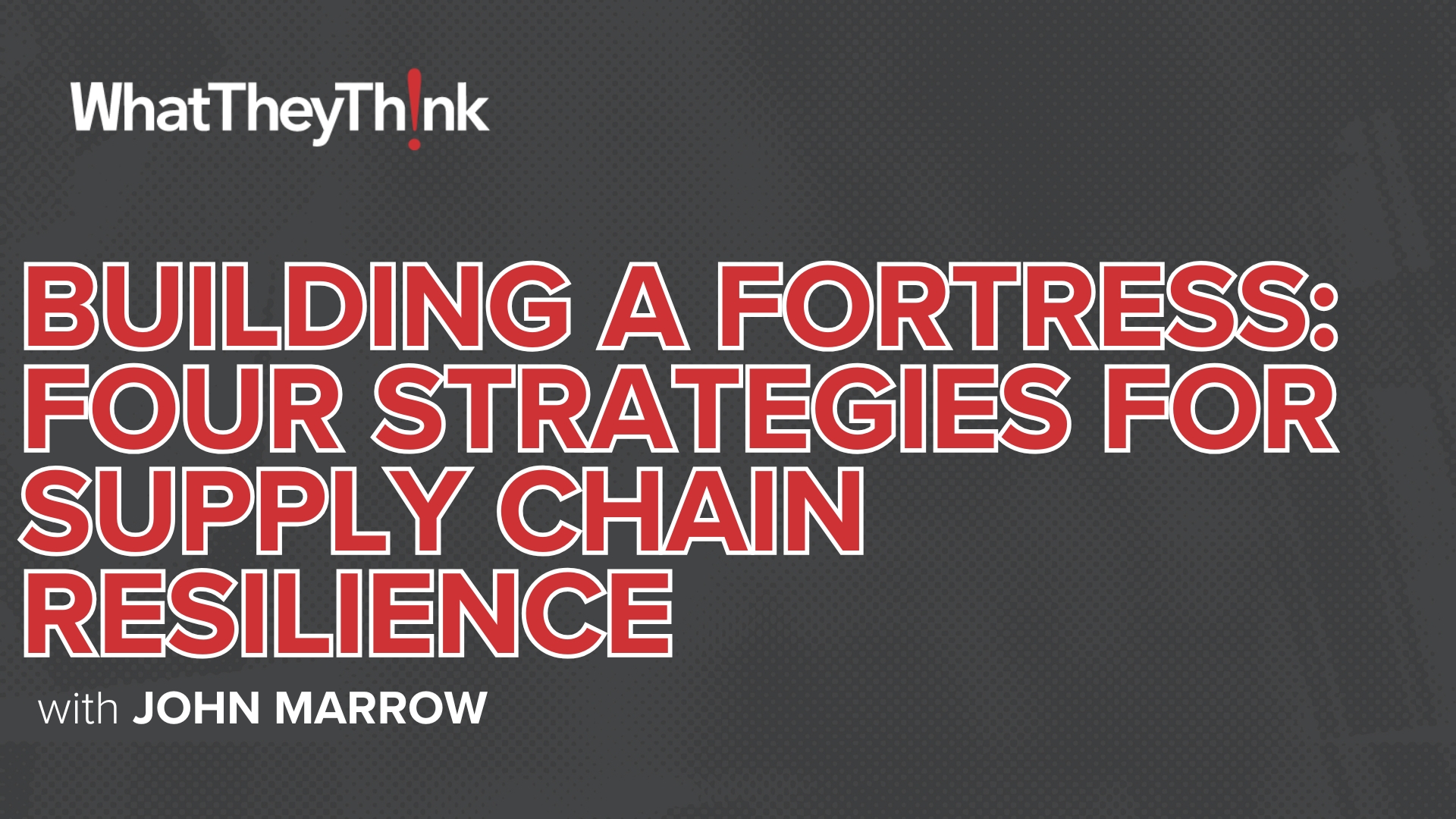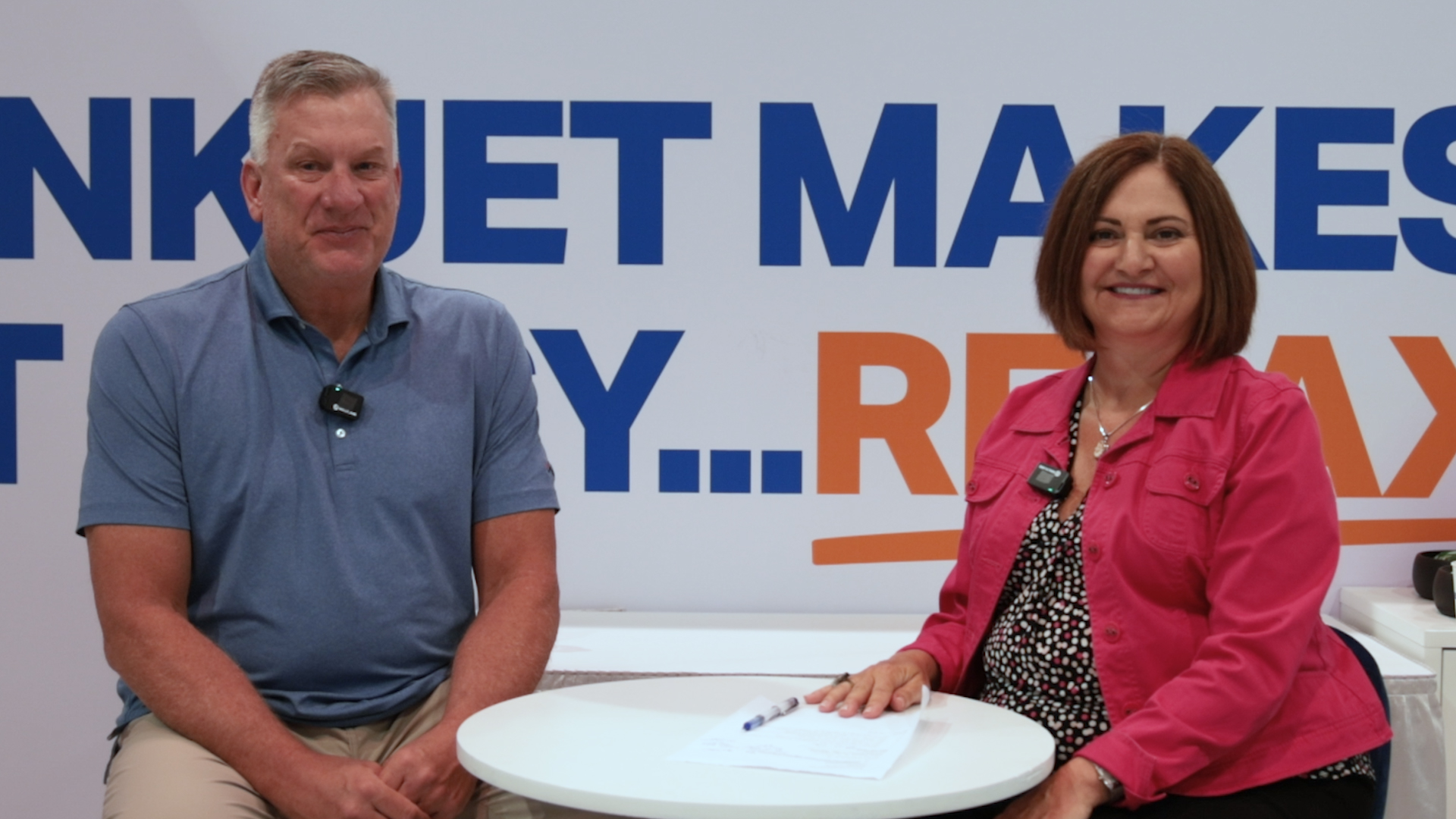Commentary & Analysis
Displaying 2251-2350 of thousands of articles
Insight You Need. Analysis You Trust.
Get the trusted insights you need to understand our evolving industry and emerging trends. Become a Premium Member.
Developing Successful Direct Mail Campaigns in the COVID Era
In today’s business climate, it is more important than ever for businesses to engage their customers and prospects via a channel that gets noticed. Although e-mail might seem like the easy choice, today’s digital inboxes are being inundated with messaging. This article explores how brands can use direct mail to connect with their customers and stay top of mind during the pandemic.
KODAK SONORA Process Free Plates: An Interview with John O’Grady, Senior Vice President, Kodak
In this article, sponsored by Kodak, Senior Vice President John O’Grady discusses the advantages of KODAK Sonora Process Free Plates, including the environmental benefits and pressroom savings that can be realized with process free plates. He also previews the improvements to come in the next-generation SONORA XTRA plates.
Digital Textiles Are Evolving: The Fabrics of the Future Are Sustainably Produced and Biodiverse
Sourcing fabrics is a complex field, and finding sustainable textiles is not as easy as it sounds. It’s much easier for the large vertical brand than it is for the smaller-volume printer. All of which is further complicated by the variance in digital textile printing applications. Textiles expert Debbie McKeegan offers strategies on how to build knowledge and seek new partnerships and stakeholders.
Print Business Data in 2020/COVID-19
It is hard to think of a time in recent history when we have been so captivated by data. The COVID-19 global pandemic has had us glued to data for the better part of eight months. Data is guiding the day-to-day recommendations of epidemiologists around the world and it will also guide when a vaccine is safe to release. In any industry, a strong data foundation is critical to enable companies to make proactive decisions that will move businesses forward.
Lessons in Success During the COVID-19 Pandemic (Part 1)
As it has become clear that the economic impact of the COVID-19 pandemic will be deeper and longer than many expected, printers have an important question to ask: What differentiates the companies that thrive during a recession and those that do not? In this article, part 1 of two-part series, we look at the research and the first of three examples of printing companies that have invested and innovated their way to success.
European Print Industry Snapshot: Austria
In this bimonthly series, WhatTheyThink is presenting the state of the printing industry in different European countries based on the latest monthly production numbers. This week features a look at the printing industry in Austria.
“Do You Want Fries with That?”—Consider Incremental Selling, Part 2
Take a look at the product mix you offer. What products can you pair up or also offer to increase your offerings to customers? In part 2 of a two-part feature, Pat McGrew helps you identify the “fries” you can offer customers.
Digital Packaging Migration: Sustainability Is the Key, but What Does that Really Mean?
In biology, “adaptation is the physical or behavioral characteristic of an organism that helps an organism to survive better in the surrounding environment.” When we look at one of the newer requirements of packaging—sustainability—we tend to limit it to the ecological focus, when the more consequential focus relates to adaptation.
Three Strategies to Land 5X Deals: How to Increase Sales in Challenging Times
Salespeople who are trying to identify, develop and close big deals right now are facing unprecedented challenges. Lisa Magnuson details three strategies that will positively impact your win rates for contracts worth five times your average deal size.
Graphco’s Chris Manley Paints a Positive Picture for the Printing Industry
The pandemic and the economic and political uncertainty have cast a pall on many aspects of our lives. But it’s not all bad news. Graphco President Chris Manley joins the chorus of voices that sees growth and opportunity in printing—some going as far as to call it the Golden Age of Printing. Here’s how Manley explains it.
Sizing the European Printing Industry: Italy
With €10.6 billion in revenue and more than 62,000 employees, the graphic arts industry in Italy is sizeable and the third biggest in Europe. But there are additional print segments as well adding to a total print market of close to €19 billion. This is the third part of a series of articles on the size of and trends in the printing industry in key countries in Europe.
Around the Web: Fungal Fashion. Connected Clothing. Fision Fitting. Green Graphics. Maddening Mystery. Eel Economics. Piano Producer. Geyser Gourmets. Marvelous Mammals.
Two words: mushroom leather. Sustainable wipes. Fashion meets the Internet of Things, for some reason. German e-commerce company acquires body scanning technology developer. Coroplast campaign signs can and should be recycled. The world’s most difficult murder mystery/puzzle—“Cain’s Jawbone”—is solved for only the third time in almost 90 years. The eel as a unit of currency in Medieval Britain. Nannette Streicher, a “mechanical wunderkind,” was an 18th-/19-century piano builder who made Beethoven’s pianos. The world’s most Instagrammed train stations. PSA: don’t cook a chicken in Yellowstone’s hot springs. All that and more in WhatTheyThink’s raccoon-menaced miscellany.
Graphic Arts Employment—October 2020
October 2020 employment figures are at least moving in the right direction from September, albeit slowly; overall printing employment in October was up +0.8% from September, with the gains predominantly in production staff continuing to come back. Let’s not look at year-over-year changes in graphic arts employment.
Where Design Color and Textile Printing Interconnect, the Workflow Must Be Digital
From the outside, digital textile printing can look like a plug-and-play operation; but for the specialist practitioner, the commercial reality is often quite different … until now. Textiles expert and WhatTheyThink contributor Debbie McKeegan shares insight into some of the technology advances that can make the process easier without sacrificing quality and accuracy.
A Sign of the Times: Three Ways COVID-19 Made the Signs and Graphics Industry more Essential than Ever
The signs and graphics industry has become essential to the recovery of small business communities worldwide, and its value has only grown as the pandemic has gone on. Guest contributor Mike Cline, Vice President of Franchise Development at Alliance Franchise Brands, looks at three ways meaningful graphic displays have shown to be a crucial tool for businesses in both the fight against, and recovery from, the coronavirus.
Digital Stress Provides an Opportunity for Print
Although many have adjusted to the changes brought on by COVID-19, 2020 has undoubtedly been a very strange year. A sudden over-dependency on digital channels opens the door for print to present itself as a positive alternative during a stressful year.
Talent Acquisition Strategy for the New Normal
The pandemic has changed both the way companies seek to attract new talent and the interview/on-boarding process. In this article, Arnold Kahn & Dino Scalia of PrintLink offer five steps for hiring and keeping great employees during and after the pandemic
The Digital Trade Printer: A New Approach to an Old Idea
Harvard Pinnacle Group in Waltham, Mass., is a digital trade printer. Owner Greg Wallace started the company as a Macintosh training center, and his need for training materials moved him into printing. The company was born digital and has stayed digital.
Learning from Others’ Mistakes: Mailing Disasters from the USPS
When you get a chance to learn from someone else’s mistakes, take the opportunity while you can. In a document titled “Top 10 Mailing Mistakes,” the United States Postal Service offers four examples of mistakes in formatting and design that rendered the mail pieces of four real-life marketers unmailable.
COVID-19 Sales Strategy: Think of Your Customer’s Customer
Selling during the pandemic is like selling during a widespread economic downturn. You have to figure out the market segments that are least impacted or, in COVID-19’s case, find the companies that are positively impacted. Directing your sales efforts is critical to closing new business.
A Matter of Degrees: Temperature Detection Systems and Signage
As we enter “the new normal,” temperature detection systems and signage may become important elements of compliance and liability for businesses. This article looks at Altoros, a veteran professional IT services and software provider that has entered the temperature signage market.
Digital Packaging Migration: What’s Taking So Long?
The cost of printing has always been important. For packaging, which has volume counted in the tens of thousands to millions of pieces of each, it is a primary focus. Since the product manufacturing and time to market are dependent on it, not only is the cost of packaging important, but also the level of productivity.
drupa 2021 Essentials of Print: Digital Print for Corrugated—The Future Condition of Things
Despite the technology’s relative infancy, the choice of digital printers is already so widespread that you have to understand every detail of what you are buying before making a decision. Getting it wrong is likely to be very costly! In this article, corrugated industry veteran Nick Kirby looks all the variables involved in selecting a digital corrugated press.
Develop New Agility: Continuous Evaluation Is the Key to Success
Agility is not an elusive concept, neither is it a disruptive, one-time effort. Rather, it is a quantifiable system of continuous evaluation of your fundamental business practices. The stepping-off point is an assessment of the core practices from which your business culture emanates. Preston Herrin identifies three phases with which you can build purpose and agility into your organization and continually nurture it with the discipline of continuous improvement.
Digital Textile Printing 2020 Overview: AATCC and PRINTING United Alliance Digital Textile Printing Conference Goes Virtual
There is no question 2020 has been an unusual year across the board, and especially in the textiles and apparel industry. As the year comes to a close, be sure to attend the 2020 Edition of AATCC and PRINTING United Alliance’s Digital Textile Printing 2020 conference, packed full of the information you need to finalize your plans for a successful 2021 and beyond. Check out the details.
The State of the USPS: It’s Been a Rocky Year for the US Postal Service
Christine Erna looks at the status of the US Postal Service, and provides a reality check to some myths and misinformation that had been proliferating in the run-up to the 2020 election.
Moving Messages: Vehicle Graphics Are an Effective Advertising Platform
A lot of shops have been doing vehicle graphics for many years, but even more have mot net explored the opportunities to be had. And as with virtually everything else, the COVID pandemic has the potential to alter the market for vehicle graphics.
Deconsolidation of the Consolidators—October 2020 M&A Activity
LSC Jettisons Creel Las Vegas Before Final Sale to Atlas, Brook & Whittle Acquires, Traxium Files Bankruptcy, and more…
Folding Paperboard Box Manufacturing Establishments—2010–2018
In 2010, there were 491 establishments in NAICS 322212 (Folding Paperboard Box Manufacturing). By 2018, that number had declined to 440, despite a spurt of post-recession growth. In macro news, the BEA’s advance estimate of 3Q GDP saw it increasing +33.1%—a climbing out of Q2’s -31.4% hole.
Around the Web: Postal Performance. Fictional Fragrance. Ballpoint Bio. News Negation. Java Jacket. Canvas Cosplay. Cetacean Savior.
A street-corner performance artist writes and mails “pick-me-up” letters. Powell’s Books is selling the smell of its bookstore. A history of the ballpoint pen, the “smartphone of its era.” The controversy over “unpublishing.” AI-enabled camera mistakes a ref’s head for a soccer ball. New Kickstarter for a coat made from “coffee yarn.” A malfunctioning 3D printer inspires a new form of textile. At “The Bob Ross Experience,” fans can dress up as and paint along with the PBS art instructor. A 3D art “performance” at the Brussels airport. A whale sculpture prevents a train from plummeting to its doom. All that and more in WhatTheyThink’s post-electoral miscellany.
Leveraging LinkedIn to Stay Connected
When it comes to developing a sales strategy, LinkedIn is a superior platform because it has done a great job of remaining professional, clean, credible, and reliable. Although other platforms like Facebook, Instagram, and Twitter are also great tools for business development, they tend to intersect more with users’ personal lives. This article explores how LinkedIn can best be used to establish and maintain those all-important connections during the pandemic.
Why Late Fall Is the Best Time to Order Canvas Prints
Canvas prints aren’t exactly seasonal products—thanks to the online printing industry you can order excellent canvas prints all year round. But placing an order in late fall can have particular benefits, especially if you’re ordering from BestCanvas.ca. Want to know why? In this article, sponsored by BestCanvas, you’ll find out!
Paper or Plastic: Depending on the Application, Printing Digitally on Synthetic Substrates May Be Worth Premium Pricing
Digitally printing on synthetic paper and plastics is more expensive than running traditional, wood-fiber papers on press, but certain products may be worth the expense, especially in the COVID era. Contributor Mark Vruno looks at the latest in synthetic papers.
Direct-to-Garment Printing Industry Boosted by Massive Growth in Online Sales
One thing the pandemic has boosted is online shopping. And one application that is experiencing terrific growth is direct-to-garment printing, allowing consumers to personalize their T-shirts and other items. Guest contributor Peter Wright, Managing Director of Amaya Ltd., shares more information.
A Tale of Two Informed Delivery Interactive Promotions
The U.S. Post Office’s Informed Delivery service offers a free interactive campaign feature. But just because it’s free doesn’t mean you shouldn’t think it through. It’s a great opportunity. Don’t waste it!
Cracking the Code: Is Your Packaging Secure?
While product counterfeiting has been an issue for many years, brands are now determined to address the issue head on. Security is becoming a crucial part of the packaging process, especially in the age of COVID.
KODAK NEXFINITY Digital Press: Versatility that Helps Printers say “Yes”
Print service providers who can say “yes” to virtually any job are at an advantage today. This article, sponsored by Kodak, explains how the KODAK NEXFINITY is a compelling solution for printers seeking a robust, flexible, effective sheetfed digital color press, delivering running costs competitive with medium-run offset andprints up to 400% more pages per month than competing sheetfed digital presses.
User Adoption and a Useful Crisis (COVID-19)
A crisis is also an opportunity, and COVID-19 is no exception. The rate of adaptation taking place is one of the most powerful forces at play in 2020. Entire populations are expanding their comfort zones with online tools, remote learning, and working from home.
European Print Industry Snapshot: Spain
In this bimonthly series, WhatTheyThink is presenting the state of the printing industry in different European countries based on the latest monthly production numbers. This week features a look at the printing industry in Spain.
New Directory Connects Manufacturers and Suppliers to Meet PPE Needs
Colorkarma and Gerber Technology have teamed up to help local manufacturers quickly adjust and ramp up production lines to meet need for personal protective equipment (PPE). Together, they have launched a new PPE Task Force Directory.
Lane Changers and Game Changers: Competitive Diversification with Inkjet
Inkjet is not only entering new markets, it’s changing the way we think about and operate in those markets. As more printing companies adopt inkjet, we are seeing more “lane changers”: printing companies, like transaction printers and direct mailers, stepping outside their traditional segments and taking on new applications. Inkjet Insight’s Elizabeth Gooding takes a close look at how lane changing is becoming game changing.
Fan Club: Ricoh Helps Brings Virtual Spectators to UT Game Day
In the face of prohibitions on live fan attendance at sporting events, both college and pro sports teams are filling empty stadiums with printed spectators. Read how Ricoh helped two sports programs take advantage of wide-format printing to connect with fans while also helping raise money for health initiatives.
Lilly Pulitzer Gains Valuable Capabilities with Digital Fabric Printing
The story of how Lilly Pulitzer got started as a fashion designer is fascinating, and so is the story of how the company has leveraged digital printing technologies to streamline its workflow and unleash increased design creativity. Senior Editor Cary Sherburne spoke with Margaret Getty, Lilly Pulitzer Senior Associate for Woven Fabric and Trim, to learn more.
Johnson’s World—Cheese, Sausage, Mushrooms, Shipping: Expand Your Reach and Find Your Niche
Looking for new markets? Tired of the same ol’ conversations about quality and price? Think: is there a simple action or additional service that will take out the competition?
Sizing the European Printing Industry: UK
With £14 billion in revenue and about 112,000 employees, the graphic arts industry in the UK is fifth largest worldwide and the second largest in Europe. Revenues have been surprisingly stable in recent years, but COVID made a big dent in 2020 production volumes. This is the second part of a series of articles on the size of and trends in the printing industry in key countries in Europe.
North Coast Litho Continues Digital Journey with iJetColorPro Envelope Press from Printware: Investment Decision Fueled by Need for Quality, Productivity
North Coast Litho devoted a great deal of time and effort in assessing digital printing options, waiting until it could find solutions that met its extremely high quality requirements and that of its customers. It found that quality level in digital presses, acquired in 2011 and 2016, but only recently was able to find the same level of quality in an envelope press, acquiring the iJetColorPro from Printware in 2020. General Manager Bob Strohmeyer explains in this article, sponsored by Printware.
Around the Web: Frightening Figurines. Kooky Costumes. Mouse Mastication. Table Talk. Tracing Textiles. Poll Posters. Lunging Leopards.
Precious Moments figurines repainted for Halloween. A photo gallery of some of weirdest and/or ill-advised Halloween costumes ever. New eco-conscious automotive wiring is eaten by rats. A new app and connected tablecloth tells you what’s on your table, for some reason. A new book traces the history of textiles. RIT opens a digital exhibition of suffrage posters. Classic jazz album cover designs. Some questions about Burger King’s reusable packaging. Never pay for a “full contact experience” with a leopard. All that and more in WhatTheyThink’s spooktacular miscellany.
Q2 Profits Unchanged from Q1—But Still Bad
Given the lag time in the release of quarterly profits, we have to time travel back to Q2, much as it pains us to do so, where we see that annualized profits for Q2 2020 stayed steady at -$4 billion.
Rising Stars: Bolton School of Arts Graduates Scoop Industry Awards for Surface Design
UK-based Bolton School of Arts, School of Textiles and Surface Design, has worked closely with its graduates to help them find new ways to overcome the pandemic hurdles. In this article by textiles expert and WhatTheyThink contributor Debbie McKeegan, several of its award-winning graduates are featured.
Is Your Management Software Ready for Industry Convergence?
As print service providers (PSPs) onboard more applications supporting a diversified set of customers and industries, it becomes more of a challenge to manage the unique requirements of those industry segments with a single business management tool. PSPs looking to expand into new markets and applications must ensure that their business management system is up to par. This article explores how these systems must adapt to support the requirements of the future.
COVID-19 Spurs Proofing Innovation at Continental Web Press—and Wins New Business
When clients are used to traveling for press checks of color-sensitive documents, then a global pandemic severely hampers business travel, how do you continue to meet the needs of those clients? You create a brand-new proofing solution. At least, that’s what you do if you’re Continental Web Press.
The Death of Paper-Based Processes
Your business processes need to move off of paper and into software. This was important before COVID-19, and like everything else, COVID-19 has simply accelerated this trend. Paper is no longer a viable business process medium.
A Wrinkle in the Plan: Is Cut-and-Sew a Barrier to Reshoring in the Textiles Industry?
Fashion and apparel brands are trying to reshore textile production, but the finishing part of the process is proving challenging: cut-and-sew. Automation has its limitations, and skilled sewists are hard to come by domestically. Cary Sherburne looks into some of the solutions to these challenges.
Digital Packaging Migration: “Déjà Vu All Over Again”?
Can the digital packaging transition learn from commercial print transition experiences, and increase the rate of migration, or are they destined to relive the same growth pains?
“Do You Want Fries with That?”—Consider Incremental Selling
Take a look at the product mix you offer. What products can you pair up or also offer to increase your offerings to customers? Pat McGrew explains how incremental sales can be a winning strategy for print businesses.
The Show Must Go On(line): The PRINTING United Digital Experience Kicks Off with Wide Format
Yesterday, the PRINTING United Digital Experience kicked off with a day’s worth of sessions and product demos surrounding the world of Graphics and Wide Format: Hardware & Consumables. Richard Romano “attended” Day 1 and reports on the four sessions.
How the Pandemic is Affecting the Textiles Supply Chain...Or Is It?
Even before the pandemic, there was lots of discussion about how the textiles and apparel industry needed to re-examine its supply chain both for increased efficiencies and to reduce the industry’s environmental footprint. Has the pandemic accelerated this? Learn more.
Epson Launches New SureColor R-Series Printers for Signage; Resin-Based Inks Take on Latex
Epson is expanding its footprint in the signage market with the new SureColor R-Series—two 64-inch roll-to-roll printers that utilize a resin-based ink technology that is intended as an alternative to latex.
Around the Web: Candy Cruise. Academic Apparel. Novel Notions. Susceptible Satellites. Listing Letters. Sustainable Sandwiches.
Candy chutes for social-distanced trick or treating. The International Library for Fashion Research set to open in Oslo. Clever but strange inventions from the early 20th century. What would we do without GPS? A new book traces the history of alphabetical order. (No, really.) Burger King tries out reusable packaging. RIP Ed Benguiat. All that and more in WhatTheyThink’s weekly track-and-tracing miscellany.
Paperboard Container Manufacturing Establishments—2010–2018
In 2010, there were 2,205 establishments in NAICS 32221 (Paperboard Container Manufacturing). By 2018, that number had declined -11% to 1,961. In macro news, the American Institute of Architects’ Architecture Billings Index (ABI) score was up in September. This is a leading indicator for the economy in general, but also for the signage market in particular.
A Passion for Fashion: Meet Class of 2020 Graduate Amelia Hughes
It’s always exciting and rewarding to view the launch of new careers in fashion design. In this week’s article, we share the story of recent graduate Amelia Hughes and her hopes for the future in an interview conducted by textiles expert and WhatTheyThink contributor Debbie McKeegan.
Reducing Costs through Cybersecurity
A sudden shift to digital workflows has created opportunity for cybercriminals to exploit unprepared businesses. This article puts forward three low-investment tips to help print companies prevent data breaches in 2020 and beyond.
The Question Print Sales People Must Be Prepared to Answer
A seasoned print buyer offers insight into what newly minted print salespeople often do wrong and what they need to do right instead.
Talking Textiles: The Supply Chain, Sustainability, and the Impact of Digital Technologies
The COVID-19 crisis has upended the fashion industry, but it has also given the industry an unprecedented opportunity to reinvent itself for the better. Texintel CEO Debbie McKeegan discusses the supply chain, sustainability, and the impact of digital technologies on textile production.
Selling Print is Never Going Back to Normal
Sales is never going back to normal. The pandemic didn’t create anything new—it simply accelerated what was already happening. Evolve your sales team now; donuts and face to face meetings aren’t coming back.
European Print Industry Snapshot: Belgium
According to the Eurostat production index, the printing industry in Belgium did fairly well in 2019 and even during the COVID-19 crisis in 2020, despite the country being hit hard by the virus. Although production volumes in 2019 were down compared to 2015, Belgium did better than the European Union average in the production index for printing and recorded media.
Smart Photo Books: An Interview with Michal Czaicki, CEO of Printbox
Smart photo books are the next major trend in the photo products market. In this article, sponsored by Enterprise Photo Product Software provider Printbox, CEO Michal Czaicki talks about this new product area, and Printbox’s new Smart Creation photo book designer.
Corrugated Growth and Challenges Part 2: Design Opportunities and Cost Challenges
Growth projections from the pre-COVID forecast for digital print for packaging are just slightly below the initial 2019 forecast in the short term, while a longer-term forecast looks much more encouraging. However, moving from analog to digital production brings some challenges.
Ricoh Expands its Direct-to-Garment Offerings with New Ri 2000 Printer
Back in early 2016, Ricoh acquired AnaJet, a leader at the time in direct-to-garment (DTG) printing. Since that time, the company has continued to develop its DTG portfolio, recently adding a new, more productive printer to its line. We spoke with Deputy General Manager for Ricoh’s Industry Print Business, Christian Compera, to learn more.
Heidelberg Swaps drupa for Innovation Week
A small group of trade journalists was invited to get a first-hand look at products and services which were originally scheduled to launch at drupa 2020. For many journalists, this was the first on site event since the COVID-19 outbreak. The general audience will be able to experience the drupa 2020 news as part of the Heidelberg Innovation Week. WhatTheyThink European section editor Ralf Schlözer was there.
Packaging Is Changing: Is It to Our Benefit or Our Fault?
Packaging trends have been shifting since before the COVID-19 pandemic and will continue after it becomes a footnote in history, although perhaps at an accelerated pace. The real drivers for change are the rise of urban living and mega-cities and increased environmental awareness. This all means that packaging-based supply chains will continue to adapt to the growing population centers and drive packaging growth and shifts.
Around the Web: Tracking Typefaces. Maximum Multiverse. Paying Paintings. Computerized Comics. Trolley Trade. Tormented Tourist. Cyber Saint. Softer Sparrows.
A new type specimen project. A typeface for people with poor vision. Tommy Hilfiger helps make fashion more sustainable. The Large Hadron Collider may be about to locate a parallel universe. Large paintings of medical bills are sold to pay those same medical bills. Can robots be funny? Qantas sells off fully stocked drinks carts. A tourist steals “cursed” relics from Pompeii. The “patron saint of the Internet” is a millennial who is on the verge of canonization. San Francisco’s birds got quieter during lockdown. Thirteen centuries of English in two minutes. Two words: fruit ninja. Remembering Dave Chandler. All that and more in WhatTheyThink’s weekly autumnal miscellany.
August Printing Shipments—The Rebound Continues
In August 2020, printing shipments rose to $6.90 billion—the third straight month of increasing shipments—and while it’s still well below August 2019’s $7.52 billion, given where we came from, that ain’t bad.
The Paradoxes of Stress
We all, at one level or another, understand that we live in difficult times. Never before have we expected, even demanded, so much from our leaders. Meeting those expectations is the most fundamental challenge for today’s leaders. Since leadership implies followership, if we don’t meet those expectations the best we’re likely to get is disinterested and disengaged followers. We must strive to be better.
Digital Textile Printing and Sustainability: Reducing the Ecological Footprint of Printing
In order to reduce the ecological footprint of textile printing, a lifecycle assessment of the entire printing process is essential. In this SPGPrints guest article first published on Texintel.com, Jos Notermans talks about how digital technologies can improve the sustainability position of the textiles industry and reduce the environmental footprint of textile printing.
Getting the Goods Online
Although sales reps might not be able to visit offices in person for quite some time, this doesn’t mean that sales channels have been hung out to dry. There are still plenty of ways to reach customers and prospects so they can see your offerings online. This article shares some tactics for standing out from the pack and ensuring that your digital content does what you need.
Web-to-Print Product Spotlight: Propago
Most web-to-print software solutions are built inside software companies. Propago was built inside a large commercial printer. This is a unique origin story for a software platform and it tells us a lot about how and why features made it into the Propago product. Print Software Section Editor Jennifer Matt takes a close look at Propago’s web-to-print solution.
How Buyer Behavior Changes in a “Shelter in Place” World
How is shopper behavior changing as a result of the coronavirus pandemic? How does that shape the channels you use and the positioning of your messaging? One survey provides some insight.
Johnson’s World: Don’t Keep Secrets—You Are the Best Promoter for Print
It’s up to us, the people who “make stuff,” to make sure our friends and neighbors know that print is alive in their communities, and that it needs their support. A century ago no one needed to point out the importance of print as an industry; it was assumed. No longer. We need to be more vocal about the important role we play. In the latest installment of Johnson’s World, Steve Johnson explains what you can do to get the word out.
Executive Q&A: Canon Solutions America’s Francis McMahon
We caught up with Francis A. McMahon, Executive Vice President at Canon Solutions America, in the wake of the virtual thINK Ahead 2020 Conference to talk about how Canon’s customers are faring in the crisis, how Canon itself has responded, and how the crisis has demonstrated the wisdom of the Grateful Dead lyric, “Once in a while you get shown the light/In the strangest of places If you look at it right.”
Carpe Signum: Signs Come Home
The COVID pandemic has wrought many changes in the printing industry in general and the sign industry in particular, but one interesting development has been an increase in residential signage. The market for this kind of signage may not disappear once the pandemic does (if the pandemic ever does)—and it can prove to be a lucrative opportunity worth seizing.
Corrugated Growth and Challenges Part 1: If It Was Easy, Everyone Would Be Doing It
The potential opportunities in corrugated packaging are significant, but like any other process, if it was easy, everyone would be doing it. In this article, we will look at some of the technical challenges.
Take Action Now to Survive the Future
The COVID-19 pandemic is forcing the world to change quickly, and printers don’t have the luxury of waiting to see what’s going to happen. They must start getting business as quickly as possible and make up for the weeks of sale losses. To survive, it will take fast action on the part of print owners to adjust to the new post-virus economy. Luckily, most practices are already available to deal with the new dynamics. John Giles explains how many printers are reviewing their business practices as they deal with what they have learned from the lockdown.
Sizing the European Printing Industry: Germany
With €19.9 bn in revenue and more than 120,000 employees, the graphic arts industry in Germany is large—and the largest in Europe. But there are additional print segments as well, adding to a total print market of €35bn. This is the first of a series of articles on the size of and trends in the printing industry in key countries in Europe.
Why RPI’s Rick Bellamy Thinks We Are in the Golden Age of Print…and Much More
Seattle-based RPI recently made several acquisitions, actions that caught our eye in light of the uncertain times we find ourselves in. We reached out to CEO Rick Bellamy to get an update on RPI, the strategy behind the acquisitions, and Bellamy’s general feelings about the industry at large.
Converted Paper Product Manufacturing Establishments—2010–2018
In 2010, there were 4,128 establishments in NAICS 3222 (Converted Paper Product Manufacturing). By 2018, that number had declined -12% to 3,547. In macro news, the unemployment rate drops, but not entirely for the right reasons.
Around the Web: Apt Art. Fish Fashion. Sailing Sweets. Bones’n’Brands. Terrifying Telegram. Faux Font. Rocketing Roof. Biting Bot. Google ’Glyphics. COVID Christmas. Brutal Bugs.
RIT’s exhibit of early 20th-century political cartoons. Leather made from fish skin. A zipline candy delivery system for COVID-era trick or treating. Home Depot’s giant skeleton barges its way into other brands’ social media. Send a “Screaming Telegram” to that special someone? New Tarot card decks for the 21st century...and beyond. Don’t use Arial for, you know, real design. Tesla invents the “inadvertent convertible.” A dental training robot goes rogue. Google’s machine learning-based hieroglyph translator. Santa will be social distancing this year. Who is surprised that the murder hornets have a “slaughter phase”? RIP Eddie Van Halen. All that and more in WhatTheyThink’s weekly autumnal miscellany.
How Are Newly At-Home Workers Using Paper?
The ongoing COVID-19 pandemic has many of us working from home much more frequently than we did in the past. How are people who continue to work from home—at least for the time being—using paper? This article cites research from a recent Keypoint Intelligence study to explore how newly at-home workers are fulfilling paper-based business processes.
How Creative Design Is Helping CBD Packaging Stand Out
The market for CBD, a cannabis derivative has climbed from $108 million in 2014 to $845 million in 2019. Current projections have the industry growing close to the $2 billion mark by 2022. CBD and cannabis products need not only protection from the elements—they need unique custom containers and packaging that help them stand out. This article, sponsored by Renegade, looks at companies that have incorporated beautiful and innovative design elements with superb materials to stand out on store shelves.
Speed x Sustainability = The Digital Imperative
In order to achieve the change required in the textiles and apparel industry, brands and manufacturers must be able to deliver product diversity at any scale – a new generation of agile manufacturing. While this clearly requires the adoption of digital technologies, like other industries moving along the analog-to-digital continuum, it doesn’t mean that analog technologies are going away. Read this insightful piece by textiles expert and WhatTheyThink contributor Debbie McKeegan.
CJK Goes Global as Cenveo Unwinds—September 2020 M&A Activity
Cenveo sells off content services, Meyers expands label business, and more…
Pivot Points: Change Management Is an Important Factor in Today’s HR Practice
In normal times, businesses use change management techniques to help employees adjust to changes driven by things like process automation. But these “abnormal” times are driving unprecedented change throughout our lives and our businesses, and it is more important now than ever before to help our employees come to terms with the changes that are required of them in order to smoothly move our businesses forward. PrintLink’s Arnold Kahn and Dino Scalia explain how.
The State of Multichannel Marketing Year over Year
DemandMetric and PFL have released their 2020 “State of Multichannel Marketing” report, a survey of 600 marketers on their use of multichannel marketing and coordinated marketing efforts. This is the second year that the companies have paired up to conduct the research, so we look at some highlights of the year-over-year results.
Decision Fatigue in Software Implementations
Making decisions wears us out, even easy decisions like what to wear, what to eat for breakfast. Decision fatigue is something we need to manage especially when it comes to projects that require lots and lots of decisions (like Print MIS implementations).
Building a Realistic Sales and Marketing Strategy
How many meetings have you been a part of where the head of sales points fingers at the marketing team and exclaims that no leads are being delivered, therefore marketing is failing? How many meetings have you been a part of where marketing details their program and engagement plan with no feedback from the sales teams? Pat McGrew explains how to get everyone on the same page and not working at cross-purposes.
Build a More Connected Community During a Pandemic
Sign companies have had to quickly adapt to provide more relevant signs for the ever-changing situation. Signs continue to assist us in our everyday lives as we try our best to slowly get back to business.
KODAK PROSPER ULTRA 520 Press: Closing the Gap
Printers know the benchmark for quality, paper choice, and operating cost has historically been the offset printing process. That’s where Kodak’s ULTRASTREAM Inkjet Technology comes in, which is redefining what’s possible with inkjet in terms of productivity, output quality, flexibility, and customization. This article, sponsored by Kodak, takes a close look at the Kodak PROSPER ULTRA 520 press.
What Streetwear Brands’ Response to COVID-19 Says About Apparel’s Future
Thanks to James Andres from S&S Activewear for contributing this week’s textiles article. Streetwear is a style of casual clothing which became global in the 1990s. The COVID-19 pandemic and increased work from home models have also increased demand for more casual clothing. Andres talks about how streetwear has contributed to art, creativity and philanthropy and profiles the response of four streetwear brands.
A Changing Environment: Environmental Graphics Evolve with the Pandemic
Once describing the intersection of signage and décor, the application area of environmental graphics now, in the age COVID, has come to embody new kinds of signage and display graphics—and are even moving into the home.
Q2 Publishing and Advertising Revenues
From Q1 to Q2, book, periodical, and newspaper publishers, as well as advertising and related markets, saw quarterly revenues drop, some quite abruptly. For some of these markets, the pandemic only accelerated trends that had been long-ongoing.
- Questions to ask about inkjet for corrugated packaging
- Can Chinese OEMs challenge Western manufacturers?
- The #1 Question When Selling Inkjet
- Integrator perspective on Konica Minolta printheads
- Surfing the Waves of Inkjet
- Kyocera Nixka talks inkjet integration trends
- B2B Customer Tours
- Keeping Inkjet Tickled Pink
© 2024 WhatTheyThink. All Rights Reserved.














